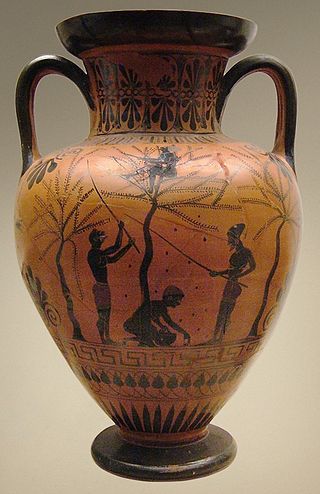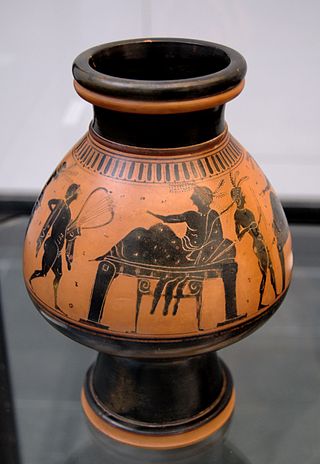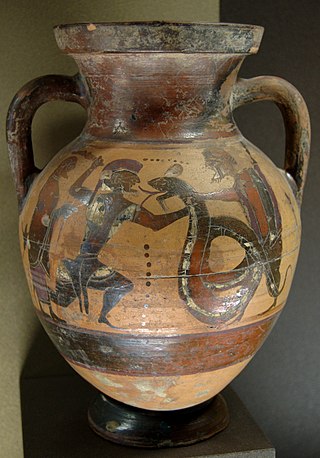
Black-figure pottery painting, also known as the black-figure style or black-figure ceramic, is one of the styles of painting on antique Greek vases. It was especially common between the 7th and 5th centuries BCE, although there are specimens dating in the 2nd century BCE. Stylistically it can be distinguished from the preceding orientalizing period and the subsequent red-figure pottery style.

Red-figure pottery is a style of ancient Greek pottery in which the background of the pottery is painted black while the figures and details are left in the natural red or orange color of the clay.

Sophilos was an Attic potter and vase painter in the black-figure style. Sophilos is the oldest Attic vase painter so far to be known by his true name. Fragments of two wine basins (dinoi) in Athens are signed by him, indicating that he both potted and painted them. In total, 37 vessels are ascribed to him, mostly amphorae, dinoi, kraters, as well as three pinakes. Apart from his work for the domestic market, he was also one of the masters of major significance in the process of supplanting the dominance of Corinthian vase painting in the markets of Etruria, and Southern Italy, the most important export area for Greek vases. His works were exported as far as the Black Sea region, Syria and Egypt (Naukratis).

The Kleophrades Painter is the name given to the anonymous red-figure Athenian vase painter, who was active from approximately 510–470 BC and whose work, considered amongst the finest of the red-figure style, is identified by its stylistic traits.

The Antimenes Painter was an Attic vase painter of the black-figure style, active between circa 530 and 510 BC.

The Providence Painter is the conventional name given to a painter of the Attic red-figure style. He was active around 470 BC.
The Marsyas Painter was an ancient Greek vase painter of the red-figure style active in Attica between 370 and 340/330 BC. The Marsyas Painter is sometimes considered the best of the Attic red-figure painters of the late 4th-century Kerch Style.
The Painter of the Dresden Lekanis is the common name for a vase painter of the Attic black-figure style, active around 580–570 BC. He emigrated to Boeotia and is in fact identical with the Boeotian Horse-bird Painter.

The Painter of Acropolis 606 was a black-figure vase painter, active around 570–560 BC.

The Ptoon Painter was an ancient Greek vase painter of black-figure style active in Athens in the middle third of the 6th century BC. His real name is unknown.

The Goltyr Painter was an Attic vase painter of the black-figure style. He was active in the second quarter of the sixth century BC. He is well known for his work on Tyrrhenian amphorae. He mostly painted animals, often with rather bulbous heads.

Group E was a group of Attic vase painters of the black-figure style. They were active between 560 and 540 BC.
Elbows Out is the name given to an Attic black-figure vase painter, active in Athens around 550/540 to 520 BC. His conventional name is derived from the strongly exaggerated gestures and odd anatomy of his dancing figures. Together with the Affecter, he is considered one of the Mannerists of the black-figure style. He painted e.g. lip cups and neck amphorae, the latter in a special shape with a heavy ovoid body. His amphorae are decorated with several friezes. His band cups resemble works by Tleson and Lydos, but are more conventional in terms of the animal motifs. He also painted a lydion, a vase shape very rarely produced by Attic potters. He is often seen as connected with the Affecter, but also with the Amasis Painter. The link with the latter should not be overestimated.

The Leagros Group was a group of Attic black-figure vase painters active during the last two decades of the 6th century BC. The name given to the group by modern scholars is a conventional one, derived from a series of name vases.

The Swing Painter was an Attic black-figure vase painter, active in the third quarter of the sixth century BC. His real name is unknown.

The Rycroft Painter was an Attic late black-figure vase painter, active in the final decade of the sixth century BC. His real name is not known.

The Lysippides Painter was an Attic vase painter in the black-figure style. He was active around 530 to 510 BC. His conventional name comes from a kalos inscription on a vase in the British Museum attributed to him; his real name is not known.

The Nikoxenos Painter was an Attic vase painter who worked in both the black-figure and red-figure styles. He was active in the end of the sixth and the beginning of the fifth centuries BC. His real name is not known.

The Gela Painter was an Attic black-figure vase painter. His real name is unknown. His long career started around the turn of the 6th and 5th centuries BC. A majority of his works, consisting mainly of lekythoi were exported to West Greece. His work was strongly influenced by the newly developed red-figure style. His style is often careless, but his images are original. Especially his mythological and genre scenes are notable. Often, his compositions on smaller vases mirror those normally used on larger, more expensive, ones. On his shoulder ornaments, he replaced the conventional buds with leaves.

Euboean vase painting was a regional style of ancient Greek vase painting, prevalent on the island of Euboea.


















